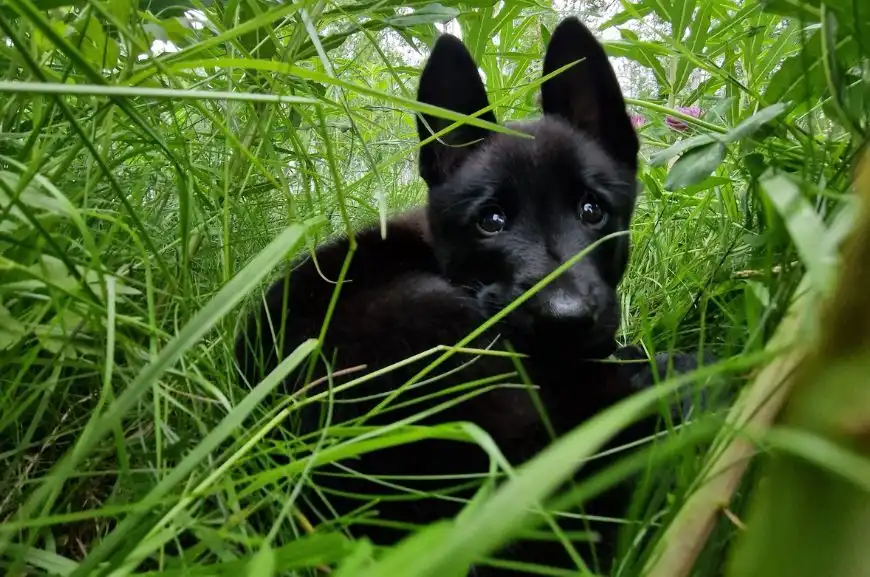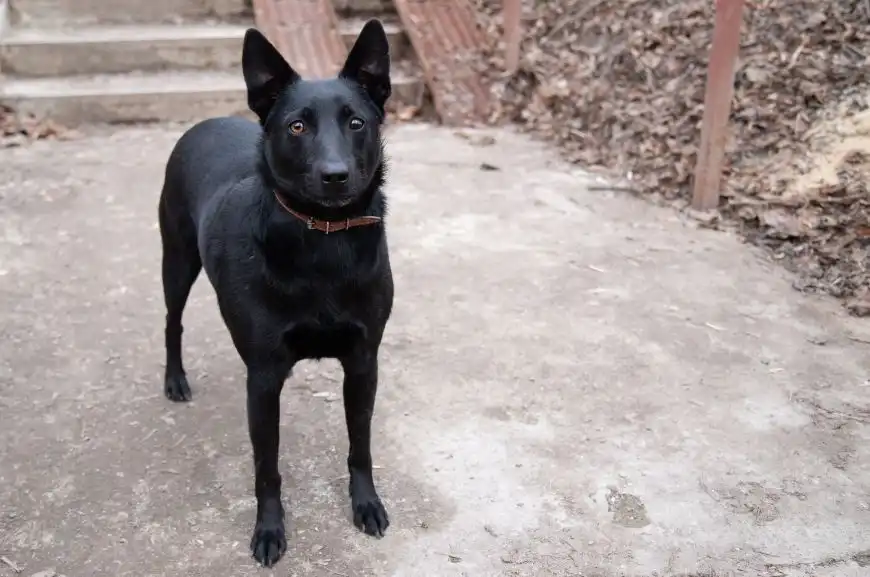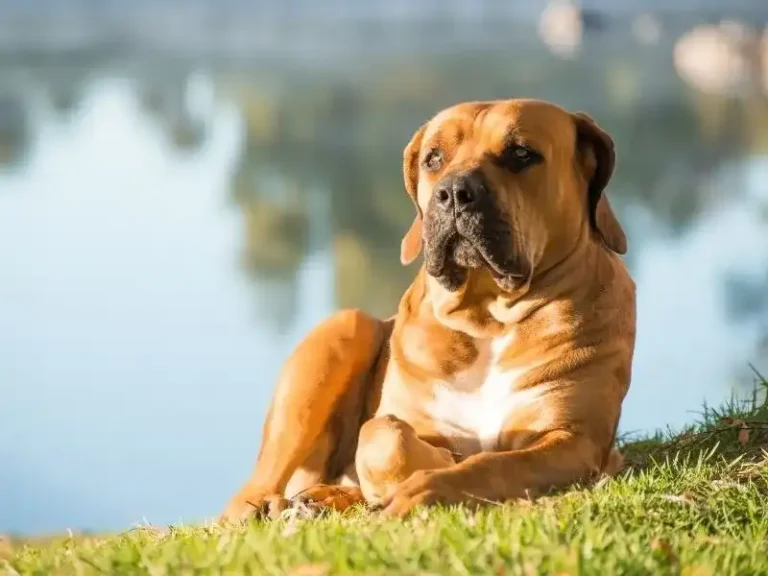Norwegian Black Elkhound Temperament
The Norwegian Black Elkhound or Norwegian Black Elkhound is an aboriginal hunting dog breed that originated in Norway. Translated from Norwegian, “elg” means “elk” and “hund” means “dog”, so the name speaks for itself: the dog was mainly used to hunt elk, sometimes other ungulates, as well as large wild animals – wild boars, wolves, lynxes. Recently, these dogs have also been used as gundogs when hunting smaller game.
The Elk Laika works well both alone and in a pack. It can search on a leash or independently. The dog has a well-developed sense of smell, hearing and sight. It carefully picks up the scent, having found potential prey, silently pursues it, and then, holding the animal in a pen, informs the owner of its location with a loud bark. Despite its small size, the dog is courageous and fearless and is able to hold such animals as a bear and a lynx.
Brief Facts about the Norwegian Black Elkhound
Do not confuse the Norwegian Black Elkhound and the Norwegian Elkhound. These are closely related dog breeds, they have the same purpose, but look different. The main differences are size and color. In the second case, the color of the dog’s coat is gray, and the dimensions are slightly larger.
Country 🇳🇴
The Black Norwegian Laika is considered a national breed of Norway, although the ancestors of the species lived throughout Scandinavia. To this day, these dogs are valued in Finland, Sweden and Denmark. There are also kennels engaged in breeding in the CIS countries. Representatives of the breed can also be found in Russia.
Group
This type of Laika, according to the FCI classification, is included in the group ” Spitz and primitive type breeds “, section “Northern hunting dogs”.
Wool
The black Elkhound has a double coat: a thick, straight, hard outer coat that lies close to the body, and a shorter, dense undercoat that is much softer than the main hair. The coat has different lengths. It is shorter on the head and the front side of the limbs and significantly longer in the chest, neck, and belly area. There are featherings on the back of the limbs and the tail.
Colors
The standard allows only one coat color – glossy black. Small whitish markings on the chest and limbs are not a fault, while white socks and well-defined white spots are considered a disqualifying feature.

Dimensions
The ideal height at the withers for males, according to the standard, is 47 cm, and for females – 44 cm. If the height of an individual is 3 cm less or 4 cm more, then this is a disqualifying defect.
Weight
The weight of Laikas fluctuates between 18-27 kg. It is not defined by the standard. However, the dog should have a harmonious, fit physique based on the height parameter.
Temperament
The Norwegian Black Elkhound is a dog with a stable psyche. It is not prone to mood swings, aggression, laziness, or cowardice. It is an active, cheerful dog with inexhaustible energy and high performance.
Representatives of the breed quickly and strongly become attached to their owners and other household members. This dog needs a lot of attention, care and affection. Without communication with a person, it becomes apathetic, and if separated from its owner for a long time, it can become depressed.
The dog is energetic and passionate in its work, and is inclined to make independent decisions. It is self-confident and courageous. Sometimes it can be stubborn and wayward, especially during puberty. However, this issue is resolved in the process of education and training, but only if the owner has experience, since the breed, despite its intelligence and quick-wittedness, is quite difficult to train.
Content
The Norwegian Black Elkhound is not a dog that is suitable for keeping in an apartment. The most acceptable option is free living in a house outside the city with an adjacent territory for independent walking. This dog does not tolerate restrictions on its freedom. It cannot be locked in a cage for a long time, and especially not put on a chain.
Representatives of the species are adapted to living outside all year round, if they have shelter from bad weather, for example, an insulated kennel. The dog tolerates cold well, but in severe frosts it is better to take it indoors.
Even with free walking in the local area, the Laika requires regular trips to the countryside. It needs increased activity, daily physical and intellectual exercise.
Fertility
The recommended age for mating a female is no earlier than one and a half years. Usually 4-8 babies are born in a litter.

Life expectancy
The average lifespan of a Norwegian Black Elkhound is 15-16 years.
Usage
In addition to excellent hunting skills, the dog has a developed territorial instinct. Nowadays, it is more often kept as a guard, but not a security guard, and also as a companion. However, this breed is suitable only for those owners who prefer to lead an active lifestyle.
Price
You can buy a Norwegian Black Elkhound in Scandinavian nurseries, as well as from private breeders in Russia and the CIS countries. The average cost of a dog is 500-600 euros. However, the final price can be both higher and lower, which is determined by the breed characteristics of the individual, the pedigree of the parents and their working qualities, as well as some other factors.
History of the origin of the Norwegian Black Elkhound
Most experts consider the Black Norwegian Elkhound to be an aboriginal breed. After all, its ancestors supposedly lived on the Scandinavian Peninsula 5 thousand years ago. However, we can speak more or less reliably about the history of the formation of the species, which dates back about ten centuries.
There is evidence in the sources that about a thousand years ago, fluffy dogs of a similar exterior lived with the Vikings and accompanied them on their conquests. Some scientists refute these facts and say that the Black Elkhound is a representative of more modern European breeds. Heidi G. Parker from the National Genome Research Institute in Bethesda conducted a genetic study in 2004, which partly confirmed this fact.
In any case, the breed developed for a long time without targeted human intervention, mainly in Norway. Hunters randomly mated stronger and more resilient individuals with good working qualities. Systematic selection began only at the beginning of the 19th century, when these dogs attracted the attention of dog breeders throughout Scandinavia and specialists from Europe. At the end of the century, representatives of the species were already actively participating in international exhibitions. In 1913, the breed was approved by the AKC, and in 1965 by the FCI.
Norwegian Black Elkhound: Breed Description

The Norwegian Black Elkhound has the following characteristic appearance features, which are fixed in the breed standard:
The head is wedge-shaped, tapering toward the nose. The skull is almost flat. The stop is well defined, has a smooth line. The nose is straight, the tip is large and black. There are no flews. The jaws are powerful, with a scissor bite.
The eyes are small, almond-shaped, set close together, and are usually dark brown in color.
The ears are triangular with pointed tips. They are set high, erect, and tilted slightly forward.
The skeleton is light, the body has well-developed muscles, athletic build. The body is square. The neck is not long, there is no dewlap. The withers are clearly defined. The back is level. The croup is wide and strong. The chest is deep. The ribs are curved. The belly is slightly tucked up.
The limbs are strong and powerful. The front ones have a slight slope along the line of the shoulder blades and shoulders, while the elbows are well attached to the body. The hind limbs are parallel. The joints are well defined. The paws are small, collected, have an oval shape. The presence of dewclaws is undesirable.
The tail is relatively short. It is set high and has a wide base. It curls into a ring and is thrown over the back.
Norwegian Black Elkhound Personality
This sociable and friendly dog is very attached to people. It is extremely loyal and loves its owner with all its soul. It may not listen to other family members, and often dominates the younger ones.
Can be jealous if there are other animals in the house: will fight for the attention and affection of the owner. Fights are possible between males. Often perceives small pets as potential prey.
The dog is patient, caring and attentive towards children. Always ready to support their active games. Never offends a child, but on the contrary, will take care of and protect him.
The Norwegian Elkhound is wary and alert with strangers. It will only make contact when it is sure that the stranger does not pose any danger.
Norwegian Black Elkhound: Maintenance and Care
Caring for a Norwegian Black Elk Husky is not difficult. To maintain a neat appearance of the pet, it is necessary to perform a number of standard hygiene procedures:
The coat should be combed 1-2 times a week, and during shedding, which is quite profuse, daily.
Bathe your dog only when it gets very dirty, but no more than 3-4 times a year.
Inspect and clean the ears once a week.
Wipe eyes as needed.
Brush your teeth once a week.
If the claws do not wear down on their own, then trim them as they grow.
Feeding
Norwegian Elkhounds can be fed both natural products and ready-made premium quality feeds . This is an active dog that spends a lot of energy. To restore its strength, it needs a nutritious and balanced diet. Its basis should be lean meat and offal, which can be mixed with boiled cereals and vegetables , seasoned with a small amount of vegetable oil.
A couple of times a week, it is recommended to give dogs processed sea fish fillet and chicken eggs . Pets that eat natural products should be fed with veterinary dietary supplements twice a year to replenish macro- and microelement deficiencies. A veterinarian will help select vitamin and mineral supplements after examining the animal.
The owner should remember that food from the owner’s table is harmful to the dog, as are a number of other products: lard , fatty meat, river fish, tubular bones, legumes, starchy vegetables, grapes . Also prohibited are sweet, salty, floury, fried, pickled, smoked, spicy dishes.
The dog should be fed after a walk or physical exercise. The number of meals and the volume of portions are determined by the parameters of the animal and its age. Laika puppies eat 4-5 times a day, and individuals after a year – twice. You can not overfeed your pet.
The only thing he should not be limited in is his consumption of clean drinking water, which he should always have access to.
Training
The Norwegian Black Elkhound is a smart and intelligent dog. However, many owners face difficulties in raising it. Firstly, this breed tends to be independent and tends to make independent decisions. The Laika will only listen to a strong authoritarian person whom it completely trusts. Secondly, these dogs are hyperactive in puppyhood and adolescence. It is difficult for them to concentrate even for a short time, so they learn commands rather slowly.

It is important to be patient in the process of training a husky, to be demanding, but fair. At first, classes should be short, and the tasks should be easy. As the dog gets involved in the process, the load should be gradually increased.
To maintain interest, it is recommended to conduct training on different sites and alternate intellectual tasks with physical activity. Positive reinforcement of the pet plays an important role, but excessive rudeness and physical violence against the animal is unacceptable: this will only lead to its aggression and even greater disobedience.
Timely socialization is important for a dog. It should be able to adequately interact with people, relatives and other animals. The husky should be accustomed to various environmental factors – cars, crowds of passers-by, loud sounds, street noise. Then the animal will experience less stress when in an unfamiliar environment.
Health
The Norwegian Black Elkhound is a breed that is known for its robust health. Representatives of the species are predisposed to certain diseases, but they are rare. Among them are:
- hip dysplasia;
- eye diseases;
- kidney dysfunction.
- To maintain your pet’s health, it is recommended:
- carry out annual vaccinations against a number of diseases;
perform treatment against external and internal parasites at least once every six months;
visit your veterinarian 2-3 times a year for a preventive examination;
In case of illness, seek help from a specialist, and do not treat the dog yourself.


One Comment